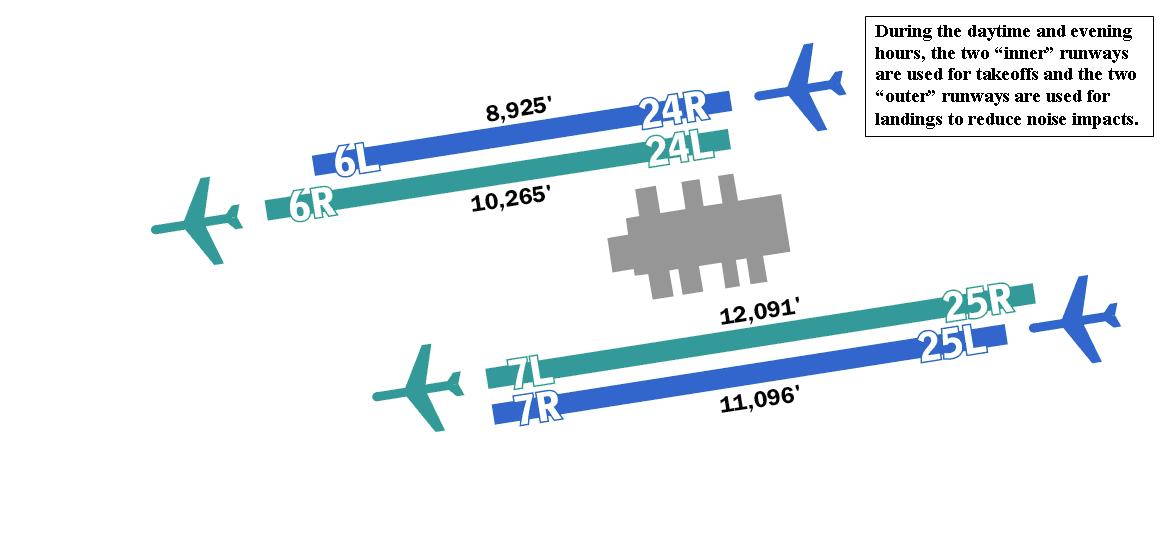Efforts to Reduce or Limit Aircraft Noise at LAX
All aircraft produce noise, but there are many steps that can be taken to reduce the amount of noise generated or to limit it to certain areas or time periods. LAWA has successfully negotiated a series of operating procedures designed to ease noise impacts over certain areas and during sensitive hours. However, the FAA has the final determination of where aircraft fly. If weather conditions are hazardous, the FAA may instruct pilots to deviate from these noise-abatement-preferred procedures and programs.
Over-Ocean Operation Procedure
From midnight to 6:30 a.m., all aircraft arriving at LAX must approach from over the ocean, unless FAA Air Traffic Control determines that weather or airport/air traffic operational conditions make it unsafe for such operations. This procedure, originally implemented in 1973, provides close-in communities to the east of the airport with some noise relief from arriving aircraft during the noise-sensitive early morning hours.

Preferential Runway Use Procedure
During the daytime and evening hours between 7 a.m. and 10 p.m., LAX prefers that the outer runways (closer to neighboring communities) are reserved for arrivals, and that the inner runways (closer in to the terminals) are used for departures, which are usually louder than arrivals. During the noise-sensitive hours between 10 p.m. and 7 a.m., FAA Air Traffic Control maximizes the use of the inner runways and taxiways for all operations to lessen community noise impacts.

Early Turn Notification Program
To minimize noise in residential communities along the north and south airport boundaries, pilots of all aircraft departing toward the west (over the ocean) must fly straight until past the shoreline before beginning any turns, unless specifically instructed otherwise by FAA Air Traffic Control. Noise Management Section staff regularly monitors all early turns to the north and south and uses recordings of communications with pilots to verify whether FAA Air Traffic Control instructed the early turns. Staff issues notification letters with supporting graphics to airlines that deviate from this procedure. A monthly report for local communities, the FAA and other interested parties is also generated. The operators of the aircraft are notified of any early turns they may have committed. The airlines are asked to investigate the incident and to respond to LAWA with an explanation of why the incident occurred and what the airlines have done or will do to correct the problem for future departures.
Restriction on Engine Run-Up between 11 p.m. and 6 a.m.
Departing and arriving aircraft are not the only sources of noise. All aircraft require regular engine maintenance and testing. LAWA requires that all idle engine checks and run-ups (engine tests) be conducted for the minimum time required to accomplish the necessary maintenance or preflight checks, with auxiliary power units also operated as minimally as possible. Run-ups of mounted aircraft engines for maintenance or test purposes are prohibited between 11 p.m. and 6 a.m., and maintenance or test running of jet engines not mounted on aircraft is prohibited unless performed in a test cell of adequate design.
Airport Operations staff regularly inspects the airfield area and tenant facilities. If they observe any unauthorized run-up activity during nighttime hours noted above, they will halt the operation as necessary.
In-Flight Monitoring Program
Noise Management staff monitors specific arrival and departure procedures for compliance with described minimum altitudes, location of aircraft and other requirements established by the FAA or contained in LAX’s Aircraft Noise Abatement Operating Procedures and Restrictions. This is accomplished by using one of the largest, most comprehensive noise-monitoring systems in the world. Staff collects noise, flight track and operations data, as well as in-flight pilot and tower radio audio records.
This ongoing program is referred to as the In-Flight Monitoring Program and monitors adherence to specific flight operations such as:
- Go-Arounds
- Loop Departures
- Monterey Park Over Flights
- Palos Verdes Peninsula Over Flights
- Short Turns
- East Departures during Over-Ocean or Westerly Operations

